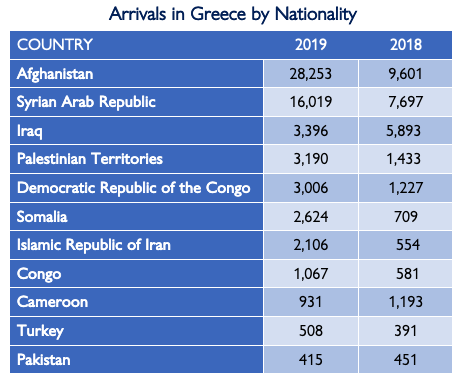-
Who we are
WHO WE AREThe International Organization for Migration (IOM) is part of the United Nations System as the leading inter-governmental organization promoting since 1951 humane and orderly migration for the benefit of all, with 175 member states and a presence in 171 countries.
-
Our Work
Our WorkAs the leading inter-governmental organization promoting since 1951 humane and orderly migration, IOM plays a key role to support the achievement of the 2030 Agenda through different areas of intervention that connect both humanitarian assistance and sustainable development.
What We Do
What We Do
Partnerships
Partnerships
Highlights
Highlights
- Where we work
-
Take Action
Take Action
Work with us
Work with us
Get involved
Get involved
- Data and Research
- 2030 Agenda
Mediterranean Migrant Arrivals Reach 4,432 in 2020; Deaths Reach 68. Focus on Greece
Geneva – IOM reports that 4,432 migrants and refugees have entered Europe by sea almost four weeks into the new year, down from the 5,266 arriving during the same period last year. Deaths, too are significantly down, at 68 men, women and children, compared with 216 at this point in January last year.
Nonetheless, at least one telling statistic already has emerged: 63 of those 68 deaths have come on the Eastern Mediterranean route linking Greece and Turkey, which compares with 71 migrant deaths on the Aegean Sea route through the entire year 2019 (see chart below).

IOM Greece
Arrivals to Greece so far are continuing their rapid pace from a year ago. The 1,939 men, women and children arriving in Greece by sea through 22 January match the same total of arrivals for all of December 2019 and fall just 140 of the total for all of January 2019, and will certainly top both periods’ arrival numbers when the month ends later this week. Arrivals on this route in 2019 barely topped 2,000 per month through the year’s first four months and did not begin the current surge until mid-summer.
If current trends hold, Greece may see an even busier migration from Turkey and the Eastern Mediterranean in 2020 than it did in 2019, when over 64,000 migrants and refugees arrived, the biggest surge since 2016.
IOM Greece this month also reported final numbers by nationality for the 2019 arrivals. Afghanistan was the top country of origin for migrants entering, with 28,253 arrivals or about 45 per cent of all arrivals during the year. Many Afghan nationals are believed to have begun their journeys to the Mediterranean after spending many years in Iran.
Syrian was the second largest source country on this route in 2019, with 16,019 arrivals. Iraq was the third largest country of origin with 3,396.
Other top senders included the Palestinian Territories (3,190), Democratic Republic of the Congo (3,006), Somalia (2,624), Islamic Republic of Iran (2,106), Congo (1,067), Cameroon (931), Turkey (508) and Pakistan (415).

IOM Athens also noted that the 2019 surge in arrivals is having an impact on Greece’s Aegean region, where in January 2019 the migrant population amounted to 14,500, while the current number in January 2020 has increased to 41,894 within the timespan of a single year.
IOM added that, since last summer, the Organization has been actively supporting the Greek authorities in their decongestion efforts. The movement of vulnerable people arriving from the islands has been prioritized and they are being transferred to open accommodation facilities on the mainland.
As in years past, the Eastern Mediterranean continues to be a preferred route for certain nationalities whose presence rarely register on either the Central or Western Mediterranean routes. Both the Republic of Congo (Brazzaville) and the Democratic Republic of the Congo (Kinshasa) are among the top senders, as is Cameroon and the Palestinian Territories. At the same time, prominent migrant nationalities such as Nigerians, Bangladeshis and Ethiopians are barely present and easily outnumbered by arrivals from much smaller countries such as Togo, Guinea and Kuwait.
There also continues to be a tiny contingent of fewer than 100 migrants arriving from Latin America. In 2019 this group was dominated by Haiti and the Dominican Republic, with a handful of others from Venezuela, Ecuador and Perú.
Meanwhile IOM is warning of a possible spill-over effect into the Western Balkans as people try to continue their journeys north into Europe.
Sub-Regional Coordinator for the Western Balkans, Peter Van Der Auweraert noted: “There are now over 100,000 migrants registered in Greece in various different forms of accommodation, up more than 70 per cent over a year ago. Many desperately want to get to other EU countries, and some will – without any doubt – start moving in greater numbers as soon as the weather warms up and the mountains are clear of snow. But accommodation centres in both Serbia and Bosnia and Herzegovina are full to capacity so we need to get ready now, because we know we are going to face many challenges come springtime.”
For latest arrivals and fatalities in the Mediterranean, click here. Learn more about the Missing Migrants Project.
See contacts here.